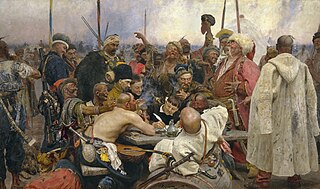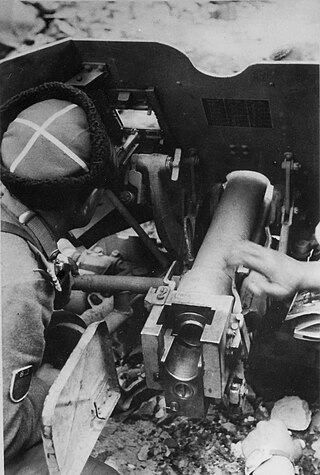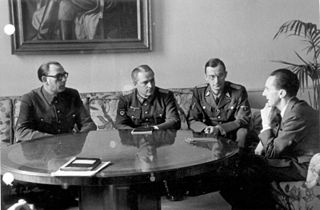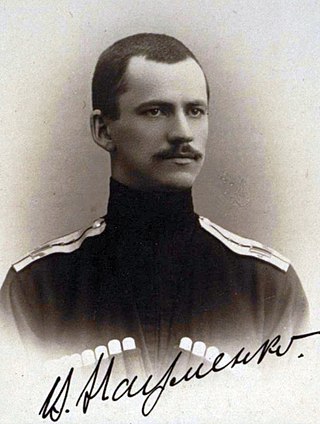Related Research Articles

The Cossacks are a predominantly East Slavic Orthodox Christian people originating in the Pontic–Caspian steppe of eastern Ukraine and southern Russia. Historically, they were a semi-nomadic and semi-militarized people, who, while under the nominal suzerainty of various Eastern European states at the time, were allowed a great degree of self-governance in exchange for military service. Although numerous linguistic and religious groups came together to form the Cossacks, most of them coalesced and became East Slavic-speaking Orthodox Christians.

The history of the Cossacks spans several centuries.

Don Cossacks or Donians, are Cossacks who settled along the middle and lower Don. Historically, they lived within the former Don Cossack Host, which was either an independent or an autonomous democratic republic in present-day Southern Russia and parts of the Donbas region of Ukraine, from the end of the 16th century until 1918. As of 1992, by presidential decree of the Russian Federation, Cossacks can be enrolled on a special register. A number of Cossack communities have been reconstituted to further Cossack cultural traditions, including those of the Don Cossack Host. Don Cossacks have had a rich military tradition - they played an important part in the historical development of the Russian Empire and participated in most of its major wars.

Pyotr Nikolayevich Krasnov, also known as Peter Krasnov, was a Russian military leader, writer and later Nazi collaborator.

Kuban Cossacks, or Kubanians, are Cossacks who live in the Kuban region of Russia. Most of the Kuban Cossacks are descendants of different major groups of Cossacks who were re-settled to the western Northern Caucasus in the late 18th century. The western part of the region was settled by the Black Sea Cossack Host who were originally the Zaporozhian Cossacks of Ukraine, from 1792. The eastern and southeastern part of the host was previously administered by the Khopyour and Kuban regiments of the Caucasus Line Cossack Host and Don Cossacks, who were re-settled from the Don from 1777.

A Cossack host, sometimes translated as Cossack army, was an administrative subdivision of Cossacks in the Russian Empire. Earlier the term viisko referred to Cossack organizations in their historical territories, most notable being the Zaporozhian Host of Ukrainian Cossacks.

The Terek Cossack Host was a Cossack host created in 1577 from free Cossacks who resettled from the Volga to the Terek River. The local aboriginal Terek Cossacks joined this Cossack host later. In 1792 it was included in the Caucasus Line Cossack Host and separated from it again in 1860, with the capital of Vladikavkaz. In 1916 the population of the Host was 255,000 within an area of 1.9 million desyatinas.
The repatriation of the Cossacks or betrayal of the Cossacks occurred when Cossacks, ethnic Russians and Ukrainians who were opposed to the Soviet Union and fought for Nazi Germany, were handed over by British and American forces to the Soviet Union after the conclusion of World War II. Towards the end of the European theatre of World War II, many Cossacks forces with civilians in tow retreated to Western Europe. Their goal was to avoid capture and imprisonment by the Red Army for treason, and hoped for a better outcome by surrendering to the Western Allies, such as to the British and Americans. However, after being taken prisoner by the Allies, they were packed into small trains. Unbeknownst to them, they were sent east to Soviet territories. Many men, women and children were subsequently sent to the Gulag prison camps, where some were brutally worked to death. The repatriations were agreed upon at the Yalta Conference; Soviet leader Joseph Stalin claimed that the prisoners were Soviet citizens as of 1939, although there were many of them that had left the country before or soon after the end of the Russian Civil War or had been born abroad, hence never holding Soviet citizenship.

De-Cossackization was the Bolshevik policy of systematic repression against the Cossacks in the former Russian Empire between 1919 and 1933, especially the Don and Kuban Cossacks in Russia, aimed at the elimination of the Cossacks as a distinct collectivity by exterminating the Cossack elite, coercing all other Cossacks into compliance, and eliminating Cossack distinctness. Several scholars have categorised this as a form of genocide, whilst other historians have highly disputed this classification due to the contentious figures which range from "a few thousand to incredible claims of hundreds of thousands".

Anti-Bolshevik Bloc of Nations (ABN) was an international anti-communist organization founded as a coordinating center for anti-communist and nationalist émigré political organizations from Soviet and other socialist countries. The ABN formation dates back to a conference of representatives of non-Russian peoples that took place in November 1943, near Zhytomyr as the Committee of Subjugated Nations/the Anti-Bolshevik Front on the initiative of the Organization of Ukrainian Nationalists. It dissolved in 1996.

The Southern Front was a military theatre of the Russian Civil War.

The XV SS Cossack Cavalry Corps was a World War II cavalry corps of the Waffen-SS, the armed wing of the German Nazi Party, primarily recruited from Cossacks.

The 1st Cossack Cavalry Division was a Russian Cossack division of the German Army that served during World War II. It was created on the Eastern Front mostly with Don Cossacks already serving in the Wehrmacht, those who escaped from the advancing Red Army and Soviet POWs. In 1944, the division was transferred to the Waffen SS, becoming part of the XV SS Cossack Cavalry Corps, established in February 1945. At the end of the war, the unit ceased to exist.

The Kuban People's Republic or Kuban National Republic was an anti-Bolshevik state during the Russian Civil War, comprising the territory of the Kuban region in Russia.

The Don Republic, later known as the Almighty Don Host, was an independent self-proclaimed anti-Bolshevik republic formed by the Armed Forces of South Russia on the territory of Don Cossacks against another self-proclaimed Don Soviet Republic. The Don Republic existed during the Russian Civil War after the collapse of the Russian Empire from 1918 to 1920.

Afrikan Petrovich Bogaewsky or Bogayevsky was a Russian military leader from the Don Cossack noble family of Bogaewsky. He served as a lieutenant general in the Imperial Russian Army and also served as the ataman of the Don Republic.

Among the approximately one million foreign volunteers and conscripts who served in the Wehrmacht during World War II were ethnic Belgians, Czechs, Dutch, Finns, Danes, French, Hungarians, Norwegians, Poles, Portuguese, Swedes, Swiss along with people from Great Britain, Ireland, Estonia, Latvia, Lithuania, and the Balkans. At least 47,000 Spaniards served in the Blue Division.

The Battle of Tsaritsyn was a military confrontation between the Red Army and the White Army during the Russian Civil War for control of Tsaritsyn, a significant city and port on the Volga River in southwestern Russia.
Nikolai Grigorievich Nazarenko was a Don Cossack emigre leader who served as president of the World Federation of the Cossack National Liberation Movement of Cossackia and the Cossack American Republican National Federation.

Vyacheslav Grigoryevich Naumenko was a Kuban Cossack leader and historian.
References
- 1 2 Tschebotarioff 1964, p. 298-300 & 365.
- 1 2 Mueggenberg 2019, p. 177.
- ↑ Mueggenberg 2019, p. 179.
- ↑ Mueggenberg 2019, p. 195-196.
- 1 2 Mueggenberg 2019, p. 196.
- 1 2 3 Mueggenberg 2019, p. 225.
- 1 2 3 4 5 6 7 Mueggenberg 2019, p. 248.
- ↑ Burleigh 2001, p. 540.
- ↑ Mueggenberg 2019, p. 249.
- 1 2 Newland 1991, p. 139.
- ↑ Mueggenberg 2019, p. 248 & 255.
- ↑ Mueggenberg 2019, p. 255.
- ↑ Longworth 1970, p. 333 & 339.
- ↑ Campbell 1965, p. 116.
- ↑ Simpson 1988, p. 271.
- ↑ Simpson 1988, p. 274.
- ↑ McKenzie, Hal (17 July 1978). "Marching in the Brotherhood of the Oppressed" (PDF). New York World.
- ↑ Mueggenberg 2019, p. 298.